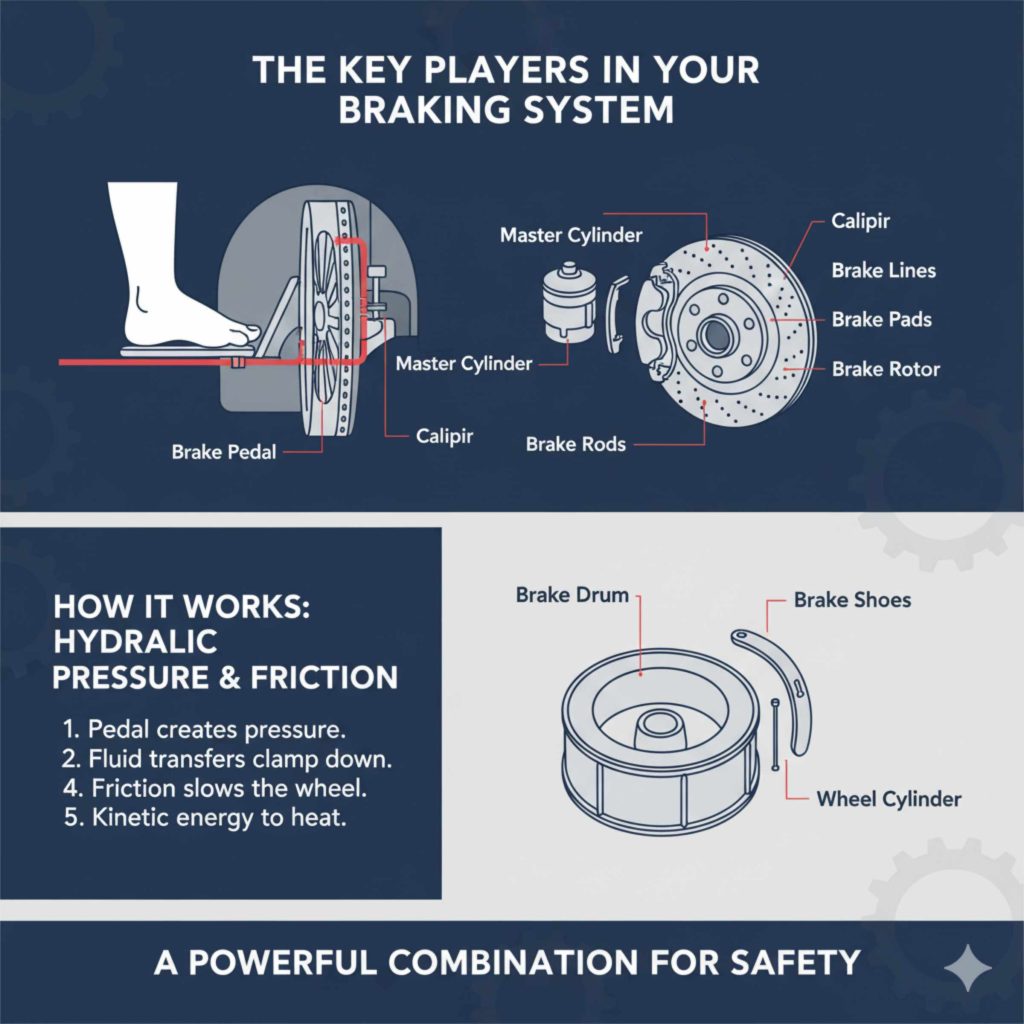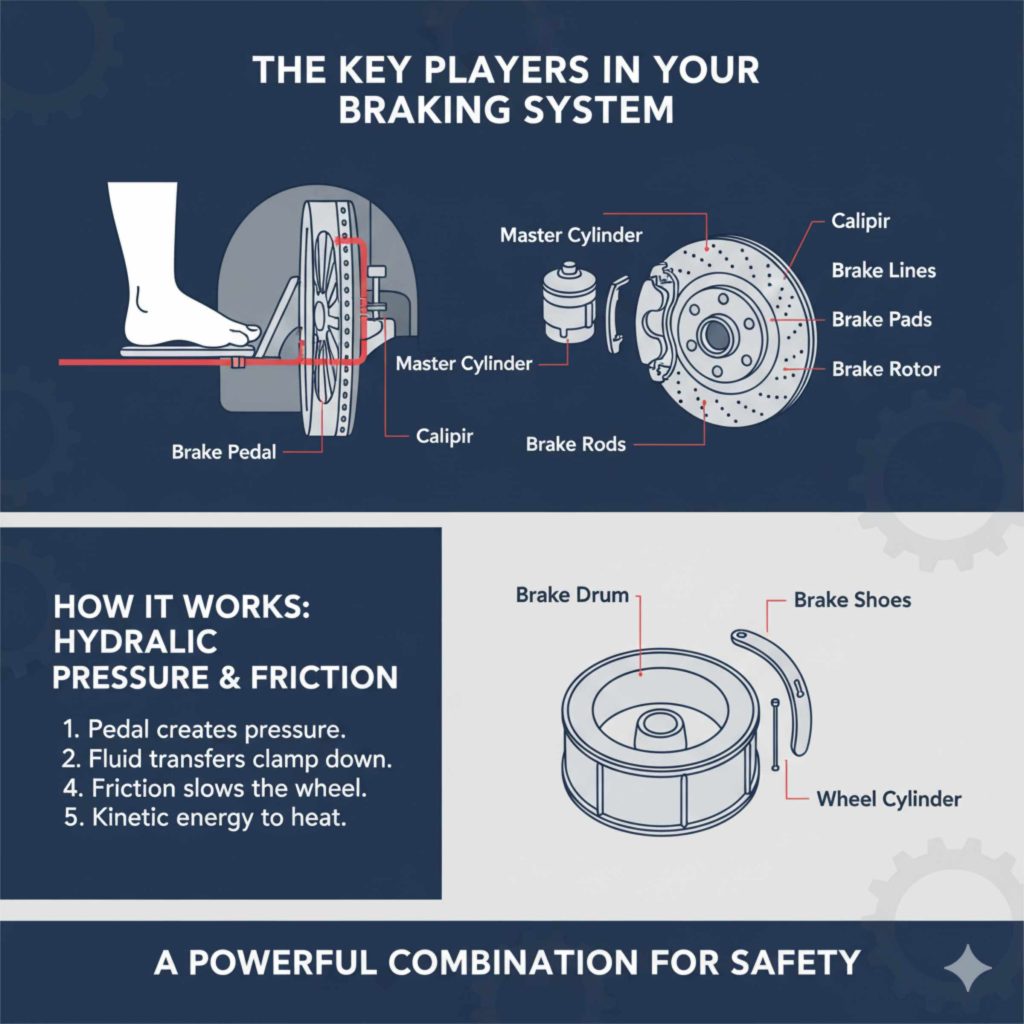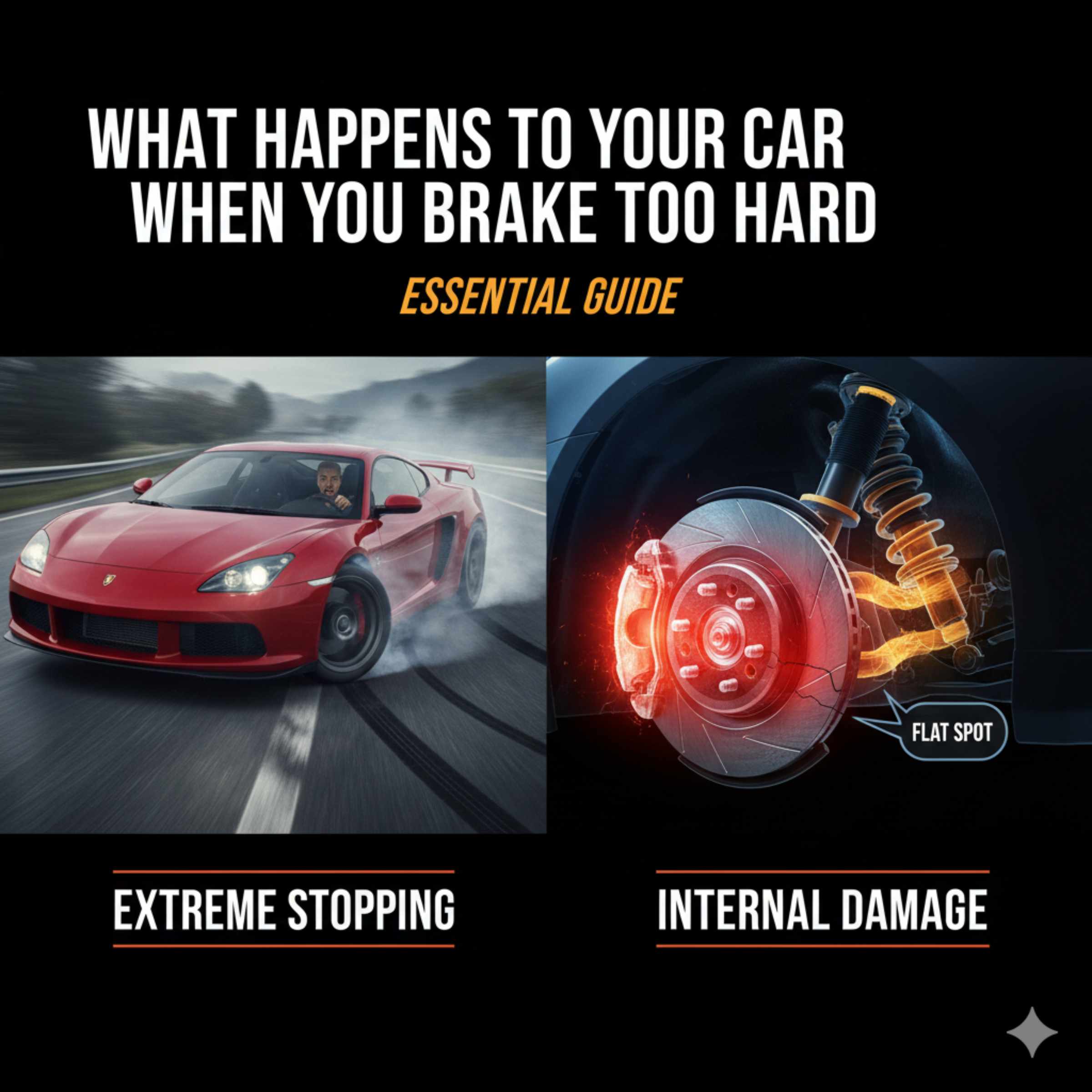Answer: Braking too hard can cause your tires to lock up, leading to reduced steering control and longer stopping distances. It also puts extra stress on your brake pads, rotors, and suspension components, potentially leading to premature wear and costly repairs. Understanding these effects helps you brake more smoothly and safely.
Ever slammed on your brakes and heard that awful screech? Or maybe you’ve felt your car lurch forward, and your stomach does a little flip? It’s a common situation many drivers find themselves in, whether it’s an unexpected obstacle or a sudden stop. While it might seem like just a momentary scare, braking too hard can actually have a surprising impact on your car. Don’t worry, though! This guide is here to break down exactly what’s happening under the hood and on the road when you brake abruptly. We’ll cover the science behind it, the potential damage, and how you can avoid these issues, all in simple terms. Ready to take the mystery out of hard braking? Let’s dive in!
The Science Behind the Stop: How Your Brakes Work
Before we talk about what happens when you brake too hard, it’s helpful to understand how braking normally works. Your car’s braking system is a marvel of engineering designed to bring your vehicle to a safe stop. It relies on a few key components working together frictionally.
The Key Players in Your Braking System
- Brake Pedal: This is where it all begins. When you press the brake pedal, you’re telling your car to slow down.
- Master Cylinder: Pushing the pedal activates a piston inside the master cylinder. This piston pressurizes brake fluid.
- Brake Lines: These flexible rubber and metal tubes carry the pressurized brake fluid from the master cylinder to each wheel.
- Calipers (Disc Brakes): At each wheel with disc brakes, a caliper acts like a clamp. When fluid pressure reaches the caliper, it squeezes brake pads.
- Brake Pads: These are friction materials that press against the brake rotors.
- Brake Rotors: These are metal discs attached to your wheel hub. They spin with the wheel.
- Wheel Cylinders (Drum Brakes): Found on some older vehicles or rear wheels, these push brake shoes outward against the inside of a brake drum.
- Brake Shoes (Drum Brakes): Similar to pads, these friction materials push against the inside of the brake drum.
When you press the brake pedal, hydraulic pressure forces the brake pads (or shoes) to clamp down on the spinning rotors (or drums). This friction is what converts the kinetic energy of your moving car into heat, slowing down the wheels and ultimately your car. Pretty neat, right?

What Happens When You Brake Too Hard?
Now, let’s get to the heart of the matter. Braking too hard pushes this system to its limits. It’s essentially a sudden, forceful application of friction.
1. Tire Lock-Up and Loss of Steering
The most immediate and noticeable effect of extremely hard braking is often tire lock-up. This happens when the force of the braking is so great that the wheels stop rotating entirely, even though the car is still moving forward. Imagine sliding on ice – that’s similar to what your tires are doing.
- Loss of Grip: When tires lock up, they lose their ability to grip the road effectively. You’re essentially skidding.
- No Steering: Crucially, a locked-up tire cannot be steered. If your front wheels lock, you can’t change direction, no matter how you turn the steering wheel. This is incredibly dangerous, as it removes your ability to steer around obstacles. Think of situations where swerving is your only option – without rolling tires, swerving is impossible.
- ABS to the Rescue (Usually): Most modern cars are equipped with Anti-lock Braking Systems (ABS). ABS is designed to prevent wheel lock-up. It rapidly pumps the brakes at each wheel, allowing them to keep rotating slightly. This maintains steering control and typically results in shorter stopping distances on most surfaces. You’ll often feel a pulsing or vibrating sensation in the brake pedal when ABS is active. If you’ve never experienced it, it can be alarming, but it’s your car’s safety system working! You can learn more about how ABS works on NHTSA’s website.
2. Increased Stopping Distance
You might think braking harder always stops you faster, but that’s not always true. While a controlled, firm brake is effective, an extreme, lock-up-inducing brake can actually increase your stopping distance, especially if you don’t have ABS or if ABS is struggling with conditions like loose gravel or ice. A skidding tire doesn’t have the same frictional grip as a tire that is rolling and being slowed simultaneously.
3. Stress on Brake Components
Your brake system is built to handle frequent use, but sudden, extreme force puts a significant strain on its parts. Imagine repeatedly bending a piece of metal; eventually, it could fatigue. Your brakes experience something similar with hard stops.
- Brake Pad Wear: Hard braking generates a lot of heat. This heat can lead to accelerated wear on your brake pads. Over time, this means you’ll need to replace them sooner than if you practiced smoother braking techniques. Some materials can even “glaze over” from excessive heat, reducing their effectiveness.
- Rotor Overheating and Warping: The rotors also bear the brunt of this heat. Excessive heat can cause them to warp, meaning they are no longer perfectly flat. Warped rotors can cause a pulsating feeling in the brake pedal when you brake and can lead to reduced braking performance. In extreme cases, they can even crack.
- Brake Fluid Issues: While less common, extremely hard braking can contribute to overheating the brake fluid. Overheated brake fluid can become less effective, making your brakes feel spongy and reducing their stopping power. This is why regular brake fluid checks and changes are important.
4. Wear and Tear on Tires
Those screeching sounds? That’s your tires protesting! Hard braking, especially lock-ups, wears down your tire tread much faster than normal driving.
- Flat Spots: When a tire skids (locks up), it grinds away rubber from a specific spot on the tire. This creates a “flat spot.” Driving on a tire with a flat spot can cause vibrations, noise, and an uneven ride.
- Reduced Tire Lifespan: Even without creating distinct flat spots, aggressive braking wears down the tire tread unevenly and much faster. This means you’ll need to replace your tires more frequently, which is a significant expense.
5. Impact on Suspension and Drivetrain
While less immediately obvious, hard braking can also stress other parts of your car.
- Suspension Components: The sudden deceleration forces that occur during hard braking put extra pressure on your car’s suspension. Components like shock absorbers, struts, control arms, and bushings are designed to absorb forces, but extreme braking can accelerate their wear.
- Drivetrain Stress: During hard braking, especially if it leads to a sudden deceleration of the wheels, some stress can be transferred to the drivetrain components (like the driveshaft and differential). While modern drivetrains are robust, consistent abuse can contribute to premature wear.
Common Causes of Hard Braking
Understanding why you might brake too hard can help you prevent it. Here are some common reasons:
- Distracted Driving: Checking your phone, eating, or adjusting the radio can take your attention away from the road, leading to delayed reactions and frantic braking.
- Following Too Closely (Tailgating): If you don’t leave enough space between your car and the one ahead, you’ll have to brake much harder when they slow down or stop unexpectedly.
- Speeding: The faster you go, the longer it takes to stop. Speeding reduces your reaction time and increases the force needed to decelerate.
- Poor Visibility: Driving in fog, heavy rain, or at night with poor headlights can make it harder to anticipate traffic situations, leading to last-minute braking.
- Inexperience or Panic: New drivers, or even experienced ones in a panic situation, might overreact and brake more forcefully than necessary.
How to Brake Smarter and Safer
The good news is that avoiding the negative effects of hard braking is largely about adopting safer driving habits and understanding your vehicle.
1. Maintain Safe Following Distances
This is perhaps the most crucial advice. The “three-second rule” is a good baseline: pick a fixed object on the road, and when the car in front of you passes it, count “one-thousand-one, one-thousand-two, one-thousand-three.” If you reach the object before you finish counting, you’re too close. Increase this distance in poor weather or at higher speeds.
2. Scan the Road Ahead
Be an observant driver! Continuously scan the road far ahead, not just the car directly in front of you. Look for brake lights, traffic signals, pedestrians, and anything that might cause a slowdown. This proactive approach gives you more time to react gently.
3. Avoid Distractions
Put that phone away! Minimize any activity that takes your eyes or mind off driving. Set your GPS before you start driving, adjust your music before you leave, and eat when you’re parked. Your full attention is your best safety tool.
4. Gentle Braking Technique
Practice smooth braking whenever possible. Apply firm, steady pressure to the brake pedal rather than stomping on it. If you have ABS, you’ll still feel it engage if you need to stop quickly, but your default should always be a controlled application of force.
5. Understand Your Brakes
Familiarize yourself with how your car feels when you brake. If your pedal feels spongy, or you hear strange noises, get your brakes checked. Regular maintenance can prevent small issues from becoming big problems.
6. Proper Tire Maintenance
Ensure your tires are properly inflated and have good tread depth. Well-maintained tires provide better grip, which is essential for effective and safe braking. You can check your tire pressure regularly with a simple gauge; it’s a quick and easy way to improve safety and fuel economy.
Table: Impact of Hard Braking on Car Components
To summarize, here’s a look at how different parts of your car are affected by braking too hard:
| Car Component | Effect of Hard Braking | Potential Consequences |
|---|---|---|
| Tires | Increased wear, potential for flat spots due to lock-up | Reduced lifespan, vibrations, need for earlier replacement |
| Brake Pads | Accelerated wear, overheating, glazing | Reduced braking effectiveness, sooner replacement needed |
| Brake Rotors | Overheating, potential for warping or cracking | Pulsating pedal, reduced braking performance, costly replacement |
| Brake Fluid | Overheating (in extreme cases) | Spongy pedal feel, reduced stopping power |
| Suspension | Increased stress on shocks, struts, bushings | Accelerated wear of suspension components |
| Drivetrain | Minor stress on components like driveshaft | Long-term, consistent abuse can contribute to wear |
When to Get Your Brakes Checked
Even if you try to brake smoothly, you might encounter situations where hard braking is unavoidable. It’s also important to know when your brakes might need attention. Here are some signs that indicate you should visit a mechanic:
- Screeching or Grinding Noises: This often means your brake pads are worn down and need replacing.
- Vibrating Brake Pedal or Steering Wheel: This is a classic sign of warped brake rotors.
- Spongy or Soft Brake Pedal: You have to push the pedal further than usual to get the car to slow down. This could indicate air in the brake lines or low brake fluid.
- Car Pulling to One Side When Braking: This suggests an issue with one of your brake calipers or brake lines.
- ABS Warning Light: If the ABS light comes on, it means the system isn’t functioning correctly and needs professional inspection.
These are crucial safety indicators. If you notice any of these, don’t delay in getting your brakes inspected. Your local mechanic can perform a thorough check of your entire braking system, ensuring it’s in optimal condition.

Frequently Asked Questions (FAQ)
Q1: Will braking hard damage my car if I have ABS?
A1: ABS is designed to prevent wheel lock-up and maintain steering. While it significantly reduces the risk of flat spots on tires and increases safety, extremely frequent and hard braking will still put more stress on your brake pads and rotors, leading to faster wear than gentle braking. ABS helps you stop safely, but it doesn’t eliminate wear and tear from aggressive braking.
Q2: How often should I get my brakes checked?
A2: It’s a good idea to have your brakes inspected as part of your regular vehicle maintenance, typically every 6 months to a year, or every oil change. Your mechanic can check the brake fluid, pads, rotors, and lines for any signs of wear or damage.
Q3: What is the difference between normal braking and hard braking?
A3: Normal braking involves a smooth, controlled application of pressure to the brake pedal, allowing the friction components to gradually slow the car. Hard braking involves a sudden, forceful application of the pedal, aiming for maximum deceleration as quickly as possible. This can exceed the optimal grip level of the tires and stress the braking system components.
Q4: Can I fix my brakes myself?
A4: While some basic brake maintenance, like checking brake fluid levels, is possible for beginners, replacing brake pads, rotors, or dealing with brake line issues often requires specialized tools and a good understanding of the system. If you’re new to car maintenance, it’s best to leave brake repairs to a qualified mechanic for safety reasons. Resources like RepairSmart offer guides, but always prioritize safety and consider professional help when in doubt.
Q5: Does driving in stop-and-go traffic count as hard braking?
A5: Frequent braking, such as in stop-and-go traffic, does contribute to brake wear over time. However, it’s usually not the same kind of extreme stress as a sudden, panicked hard brake. The key is the force and suddenness of the braking action. Gentle, regular braking in traffic is much less taxing than one or two emergency stops.
Q6: Why does my brake pedal pulse when I brake hard sometimes?
A6: That pulsing is usually your ABS working! It’s detecting that a wheel is about to lock up and is rapidly releasing and reapplying brake pressure to prevent it, allowing you to maintain steering control. It can feel unnerving, but it’s a sign your safety system is doing its job.
Conclusion
So, what happens to your car when you brake too hard? It’s a combination of immediate safety concerns and long-term wear and tear. From the tires losing grip and precious steering control to accelerated wear on your brake pads and rotors, hard braking is more than just a noisy event. It’s a stress test for several critical components of your vehicle.
The good news is that most of these issues are preventable. By adopting mindful driving habits – maintaining safe distances, staying alert, and avoiding distractions – you significantly reduce the need for sudden, forceful braking. Practicing smooth acceleration and deceleration not only keeps your car in better condition for longer, saving you money on repairs and replacements, but it also makes your driving experience safer and more comfortable for everyone on the road. Remember, your car’s braking system is vital for your safety. Treat it with care by braking smarter, and it will serve you reliably for years to come.

